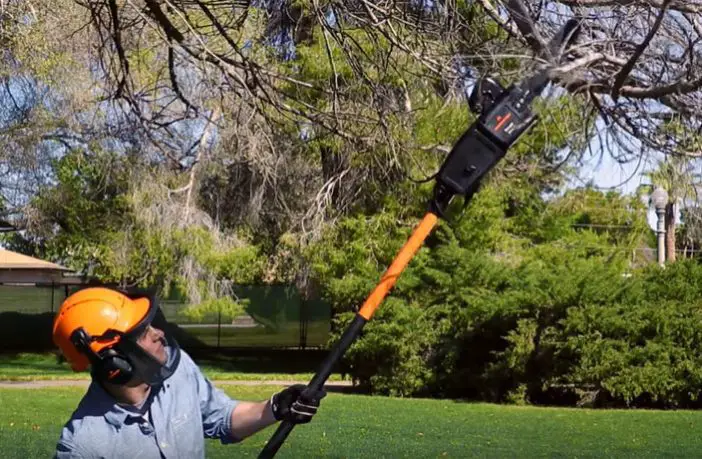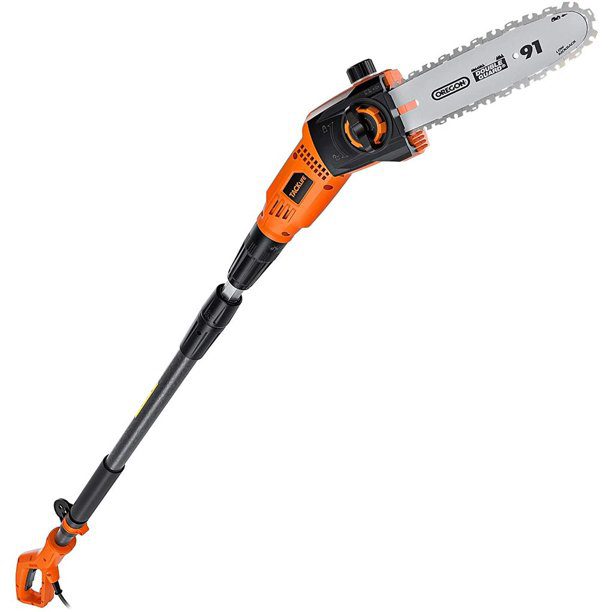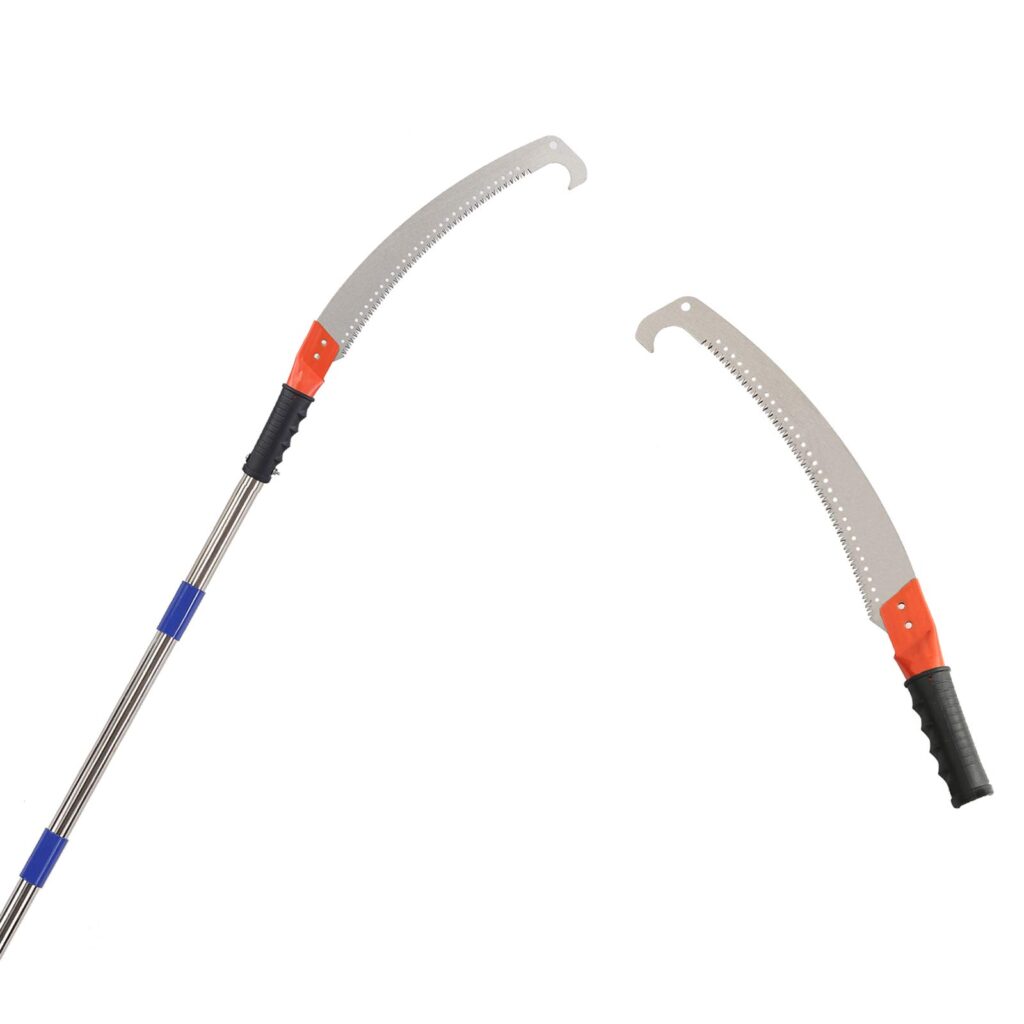To use a pole saw, follow these steps: 1) Wear protective gear. 2) Ensure the area is clear of bystanders. 3) Extend the pole to the desired length. 4) Hold the pole saw firmly with both hands. 5) Position the saw at a slight angle on the branch. 6) Start cutting using a steady, controlled motion.
Have you ever dreaded trimming the highest branches on a tree?
Trimming a tree is usually a must as the branches can accidentally fall and damage your roofing or garage. However, when you can’t reach these hard-to-reach branches using a pruning saw, the pole saw comes to the rescue.
This versatile tool can help you reach all the challenging spots, and I’ll explain in detail how to use it like a pro. So, keep reading to learn how to use a pole saw, the differences between various types, and all the safety precautions.
Table of Contents
Prepare Your Pole Saw
If you cannot reach the high branches or limbs from the ground, you need to use a pole saw. This tool is designed to reach branches located several feet off the ground, so you don’t have to stand on a ladder.
Yet, first, you must prepare your tool for work.
- Don’t attempt to trim heavier and larger branches. Wood branches that are thicker than 8 inches thick are hazardous to trim.
- Choose the right pole saw to work with. A bigger pole saw designed to reach a height of more than 8 feet can be extremely tiring to work with.
- Always work away from power lines.
- Don’t attempt to prune overhead branches until you’ve mastered the technique of reducing their weight using jump cuts. For these challenging jobs, you need to hire a professional.
- Cordon off the area or restrict access to your work area.
- Clear the work area of any tripping hazards so you can walk away.
- Hold the pole saw with both hands at a vertical position for more control.
- Stand to the side of the limb you’re pruning, ensuring that you’re holding the tool at chest level. It’s important to hold the pole saw at a 45-degree angle and not hold it up and down.
- Check the oil level to guarantee that the tool is working correctly.
Wear Your Safety Equipment
Wearing protective gear is essential while you’re working with a pole saw. These necessary accessories differentiate between a minor cut and a major injury.
- A work helmet is a must, even if you’re not attempting to cut any overhead branches. While trimming branches, it’s better to be safe than sorry.
- Your safety goggles protect your eyes from flying debris and sawdust, so you can better focus on the job.
- Using power tools for extended periods is associated with hearing loss and other issues. Therefore, wearing ear muffs or some other type of protection is important to protect your ears while working in the garden.
- Put on your non-slip gloves before working using the pole saw. These gloves provide a good grip and guarantee that you’ll be able to hold the tool steadily while working.
- Wear the right clothes for the job. Your clothes shouldn’t be too wide as they might get caught in the blade of the pole saw, and they shouldn’t be too tight as they might restrict your movement.
- Put on long pants and avoid shorts. They will protect your legs from any falling branches that might scratch your skin.
- Choose the right footwear for the job. Non-slip work shoes will allow you to move comfortably while working in the garden.
How to Use a Gas Pole Saw
Gas pole saws are more expensive and louder than electric pole saws. However, many homeowners and professionals prefer them for trimming and pruning work.
These power tools are sturdy enough to withstand working on thicker branches. A gas-powered pole saw won’t run out of power while you’re working on a large work area.
Working with this intimidating tool can be a little challenging if you’re using a pole saw for the first time. This is why I prepared this detailed guide to walk you through your first gas pole saw operation.

Step 1: Check Your Pole Saw
Before attempting to work with your pole, ensure the blade is well-assembled. Forgetting something as simple as tightening a screw can be life-threatening.
Step 2: Set the Work Plan
Many beginners make this rookie mistake as they just take the pole saw and start cutting any limb without a work plan. Unfortunately, this can lead to branches falling over one another or damaging the pole saw’s blade.
Before your first cutting attempt, you must check the pole saw’s instructions to guarantee it can handle the branch’s thickness. In most cases, the tool should be able to cut through any branch that measures between three and eight inches thick.
Step 3: Position Yourself
Grab the tool’s handle and position yourself safely away from the blade but hold the tool at chest level. You should be able to hold your pole saw with both hands for precise cutting.
Step 4: Adjust the Length
Gas pole saws can generally extend up to 12 feet, but it’s important not to set your tool too short or too long. Picking the wrong length will cause balance issues while you’re working, and you’ll have to reposition yourself.
Step 5: Turn On the Pole Saw
Balance the tool using one hand and use the other to pull the starter rope. Don’t attempt to make a cut until the pole saw is fully warmed up.
Step 6: Perform Jump Cuts to Reduce Weight
This technique won’t be necessary unless you’re trimming a heavy branch. However, it reduces the weight of the final cut and makes the whole job easier.
You should hold your pole saw under the stem and use it several times. This will help you finish the final cut faster.
Step 7: Perform Perpendicular and Vertical Cuts
You can trim your branches using perpendicular and vertical cuts. Use both hands to secure your tool and make deep cuts for perpendicular cuts.
Try a vertical cut if you can’t apply enough pressure to cut a thick limb.
How to Use an Electric Pole Saw
Electric pole saws can be corded or battery-operated. They’re both suitable for occasional pruning around the garden when using a gas-powered tool is too challenging.
Homeowners usually prefer these tools because they’re lighter and easier to use.
For an electric pole saw, you’ll need an extension cord. However, you’d still be restricted by the cord’s length.
Battery-operated models are slightly more expensive, but they’re portable. They’re lighter than gas pole saws and can be used anywhere around the garden. Nevertheless, the battery’s cost can make these models slightly more expensive.
Using an electric pole saw is pretty straightforward if you follow these steps.

Step 1: Secure the Power Supply
If you have a corded model, connect it to a power outlet and turn on the circuit breaker. You’ll have to insert the extension cord into the pole saw’s inlet to be able to move around.
If the pole saw is battery-operated, ensure the battery is well-charged before you start pruning.
Step 2: Position Yourself
Hold the pole saw with both hands and at an angle. Start by making a perpendicular or vertical cut, depending on the branch’s thickness.
Step 3: Make Other Cuts
Clean the work area before making more cuts.
How to Use a Manual Pole Saw
A manual pole saw doesn’t have an engine, so your body is the power source. As a result, it’s more difficult to use than other models.
It’s simply a long pole with a sharp blade at the end. However, a lot of homeowners pick this tool because it’s budget-friendly.
The main advantage of this tool is that it can extend longer than any other powered tool. It features ropes on the sides to make the cuts easier. Here are the right steps to use it.

Step 1: Properly Position the Pole Saw
You should be able to position your pole saw so you can use the power of gravity to make a directional cut.
Step 2: Pick the Stem
Pick the right stem which you want to cut. You should position the blade so that most teeth touch the branch.
The hook on the tip of the blade will prevent it from sliding.
Step 3: Use the Ropes
Controlling a manual pole saw can be a little challenging, but the ropes on the side will help you cut through thicker branches.
Use the ropes to control the blade and make grooves to facilitate deeper cuts. Once you’ve made the grooves, use them as a guide to making the desired cut.
Wrap Up
A pole saw is a versatile tool that allows you to trim and prune taller branches without standing on a ladder. It’s easy to use if you follow the needed precaution and the right steps.
There are three types of pole saws, and each one comes with some pros and cons. Operating pole saws starts with preparing the work area and choosing the right branch to trim. It takes a little practice, but soon enough, you’ll be able to do all the pruning work with great precision.
